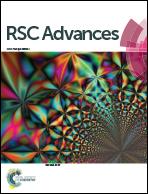Synthesis of surface ion-imprinted magnetic microspheres by locating polymerization for rapid and selective separation of uranium(vi)†
Abstract
Uranium(VI) may pose a great threat to human health and the environment owing to its high chemical toxicity and radioactivity. A novel method is reported herein to synthesize surface ion-imprinted magnetic microspheres (SII-MM) for efficient removal of uranium(VI). Specifically, uranyl ion-imprinted polymer-functionalized Fe3O4@SiO2 microspheres were prepared by surface-locating copolymerization of N-hydroxyethylacrylamide and 1-vinylimidazole. The effects of chemical composition, pH, adsorbent dose, competing ions and initial concentration on the adsorption of uranyl ions were evaluated. The exothermic spontaneous adsorption kinetically followed a pseudo-second-order model, and the process of SII-MM could reach equilibrium with a capacity of 146.41 mg of U per g within 1.0 min at pH 5.0 and 298.15 K. Compared with non-imprinted composites, SII-MM showed higher selectivity, faster kinetics, and larger capacity for uranyl adsorption. This work indicates that the SII-MM can be used as a promising adsorbent to effectively remove uranium(VI) from aqueous solutions.


 Please wait while we load your content...
Please wait while we load your content...